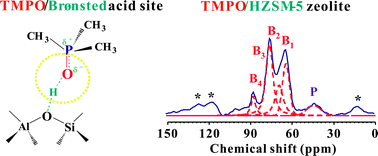Acid properties of solid acid catalysts characterized by solid-state 31P NMR of adsorbed phosphorous probe molecules
Abstract
A brief review is presented on acidity characterization of solid acid

* Corresponding authors
a
Wuhan Center for Magnetic Resonance, State Key Laboratory of Magnetic Resonance and Atomic and Molecular Physics, Wuhan Institute of Physics and Mathematics, Chinese Academy of Sciences, Wuhan 430071, China
E-mail:
dengf@wipm.ac.cn
Fax: +86-27-87199291
b Department of Chemistry, National Taiwan University, Taipei 10617, Taiwan
c
Institute of Atomic and Molecular Sciences, Academia Sinica, PO Box 23-166, Taipei 10617, Taiwan
E-mail:
sbliu@sinica.edu.tw
Fax: +886-2-23620200
d Department of Chemistry, National Taiwan Normal University, Taipei 11677, Taiwan
A brief review is presented on acidity characterization of solid acid

 Please wait while we load your content...
Something went wrong. Try again?
Please wait while we load your content...
Something went wrong. Try again?
A. Zheng, S. Huang, S. Liu and F. Deng, Phys. Chem. Chem. Phys., 2011, 13, 14889 DOI: 10.1039/C1CP20417C
To request permission to reproduce material from this article, please go to the Copyright Clearance Center request page.
If you are an author contributing to an RSC publication, you do not need to request permission provided correct acknowledgement is given.
If you are the author of this article, you do not need to request permission to reproduce figures and diagrams provided correct acknowledgement is given. If you want to reproduce the whole article in a third-party publication (excluding your thesis/dissertation for which permission is not required) please go to the Copyright Clearance Center request page.
Read more about how to correctly acknowledge RSC content.
 Fetching data from CrossRef.
Fetching data from CrossRef.
This may take some time to load.
Loading related content
